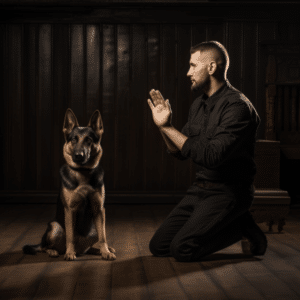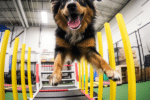Mastering Dog Obedience: Sit, Down, and Come Commands

Teaching essential obedience commands to your dog is a crucial aspect of training that can greatly enhance your relationship and ensure a well-behaved pet. The first command to teach is “sit,” which can be done using a food lure method. Hold a treat in front of your dog’s nose and lift it above their head, prompting them to lower their rear end to the ground. Once they understand this command, introduce the verbal cue “sit” before moving the treat. You can also teach “sit” from a down position by moving the treat from in front of their nose to between their eyes.
The second command to teach is “down.” The food lure method involves holding a treat in your hand, asking your dog to sit, and then lowering the treat straight down to the floor. Once your dog’s belly hits the floor, praise and reward them. Eventually, you can phase out food treats and use verbal cues only. Another method is the under-the-leg method, where you sit on the floor with your dog and use a treat to lure them under your leg into a lying down position.
The third command is “come,” or recall. Start practicing indoors or in a fenced backyard with minimal distractions. Use a treat to back up a few feet, squat down, and open your arms in a welcoming gesture. Wiggle the treat and enthusiastically call your dog to come. When they start moving towards you, praise and encourage them. Repeat the exercise and gradually introduce longer distances and distractions. Avoid punishing your dog when they come to you and make the recall command a positive experience.
Overall, consistency and positive reinforcement are key when teaching obedience commands to your dog. Gradually increase the difficulty level and practice in different environments to ensure reliable responses.

The First Command: Sit
The first command to teach your dog is “sit,” and it can be accomplished using the food lure method. This method involves holding a treat in front of your dog’s nose and lifting it just above their head. The natural reflex is for your dog to lower their rear end to the ground, resulting in a sitting position. Once your dog understands the command, you can introduce the verbal cue “sit” before moving the treat.
Using the food lure method, you can also teach your dog to sit from a down position. Begin by holding a treat in front of your dog’s nose, then gradually move it from in front of their nose to between their eyes. This will prompt your dog to shift from a lying down position to sitting. Remember to praise and reward your dog when they successfully perform the command to reinforce their behavior.
When teaching the “sit” command, consistency is key. Use the same hand signal and verbal cue each time you want your dog to sit, and be sure to reward them with praise or a treat for their success. Practice this command in different environments and gradually increase the difficulty level by introducing distractions or longer distances. By doing so, you will ensure that your dog’s obedience commands are reliable in any situation.
| Command | Method |
|---|---|
| Sit | Food Lure Method |
| Down | Food Lure Method or Under-the-Leg Method |
| Come | Recall Training |
Overall, teaching your dog essential obedience commands, starting with “sit,” is crucial for their training and behavior. Using the food lure method, you can effectively teach your dog to sit and reinforce their understanding of the command. Remember to be consistent, praise your dog’s efforts, and gradually increase the difficulty level to ensure reliable responses in various environments.
Teaching Sit from a Down Position
If you prefer, you can also teach your dog to sit from a down position by using the food lure method. This method is helpful for dogs who naturally tend to lie down before sitting. Start by holding a treat in front of your dog’s nose and guiding it towards their chest, between their front legs. As the treat moves closer to their chest, their hind end will naturally lower to the ground, bringing them into a sitting position. Once they are sitting, praise and reward them with the treat.
This technique helps reinforce the concept of sitting from a down position and enhances your dog’s understanding of the command. It allows you to establish a reliable response to the “sit” command in multiple situations. Remember to consistently use the verbal cue “sit” along with the food lure to reinforce your dog’s understanding of the command.
Dog’s Understanding
To ensure successful training, it’s important to practice this command in different settings and gradually introduce distractions. This helps your dog generalize the learned behavior and respond reliably even in unfamiliar environments. Consistency is key throughout the training process, ensuring that your dog understands and consistently responds to the “sit” command from a down position.
| Method | Advantages | Disadvantages |
|---|---|---|
| Food Lure Method | Effective for dogs who naturally lie down before sitting | May require more patience and practice |
| Verbal Cue Reinforcement | Establishes a reliable response to the “sit” command | Requires consistent use of the verbal cue |
| Generalization through Practice | Ensures reliable responses in different environments | May take time for dogs to generalize the command |
By using the food lure method and reinforcing the verbal cue, you can effectively train your dog to sit from a down position. Remember to be patient, consistent, and gradually increase the difficulty level as your dog becomes more proficient. With practice in different environments, your dog will master this obedience command and enhance their overall obedience training.
The Second Command: Down
In dog obedience training, teaching the “down” command is crucial for establishing control and ensuring your pet’s safety. This command teaches your dog to lie down on command, which can be especially helpful in situations where you need your dog to calm down or stay in one place. The food lure method is an effective technique for teaching the “down” command, providing clear guidance and positive reinforcement.
To start training your dog to “down,” follow these steps:
- Hold a treat in your closed hand and let your dog sniff it.
- Slowly lower the treat to the floor, guiding your dog’s nose towards the ground.
- As your dog follows the treat with their nose and starts to lower their body, say the command “down.”
- Once your dog is in a lying down position, praise and reward them with the treat.
- Repeat these steps, gradually phasing out the use of a treat and relying more on the verbal cue.
Consistency is key in obedience training, so make sure to practice the “down” command regularly. As your dog becomes more familiar with the command, you can introduce distractions to increase the difficulty level. Remember to always reward and praise your dog when they successfully obey the command, reinforcing the desired behavior.
“Teaching the ‘down’ command using the food lure method can be highly effective in obedience training. It helps your dog understand that lying down on command is expected behavior. With patience and consistency, your dog will learn to respond reliably to the ‘down’ command.”
Table: Step-by-Step Guide to Teaching the “Down” Command using the Food Lure Method
| Step | Instructions |
|---|---|
| 1 | Hold a treat and let your dog sniff it. |
| 2 | Lower the treat to the floor, guiding your dog’s nose towards the ground. |
| 3 | Say the command “down” as your dog follows the treat and starts to lower their body. |
| 4 | Praise and reward your dog when they are in a lying down position. |
| 5 | Practice regularly, gradually phasing out the use of a treat and relying more on the verbal cue. |
Teaching Down Using the Under-the-Leg Method
In addition to the food lure method discussed in the previous section, another effective technique for teaching the “down” command to your dog is the under-the-leg method. This method involves luring your dog into a lying down position by hiding a treat under your leg and guiding them into the desired position.
To start, stand with your dog in front of you and hold a treat in your hand. Place your leg slightly forward so that it creates a barrier between you and your dog. The treat should be hidden between your fingers, out of sight from your dog. Slowly lower your hand and guide your dog’s nose towards the treat, which will naturally cause them to lower their body into a lying down position.
Teaching Down
Once your dog is in the down position, praise them and offer the treat as a reward. Repeat this process multiple times, gradually reducing the dependence on the treat lure and using a verbal cue, such as “down,” to signal the command. Remember to be patient and consistent with your training sessions, as repetition and positive reinforcement are key to success.
By utilizing the under-the-leg method, you can teach your dog the “down” command in a fun and engaging way. This technique helps establish trust and cooperation between you and your pet, while reinforcing good behavior and obedience. With practice, your dog will quickly learn to respond to the verbal cue and reliably perform the “down” command.
| Benefit | How It Works |
|---|---|
| Engaging Technique | The under-the-leg method adds an element of novelty and excitement to the training process, making it more enjoyable for both you and your dog. |
| Building Trust | By using positive reinforcement and gentle guidance, you strengthen the bond between you and your pet, enhancing trust and cooperation. |
| Reliable Response | Consistent practice with the under-the-leg method helps your dog understand and obey the “down” command, resulting in a reliable response in any situation. |
The Third Command: Come
In dog obedience training, the “come” command, also known as recall, is a crucial skill that ensures your dog’s safety and allows for more freedom during outdoor activities. Teaching your dog to come when called is essential for their well-being and your peace of mind. Here, we will explore the step-by-step process of training this command, highlighting key factors for success.
First and foremost, it is important to start the training in a controlled environment with minimal distractions. Begin in a quiet room or a fenced area where your dog can focus solely on you. Use a calm and enthusiastic tone when calling your dog’s name followed by the “come” command. This encourages a positive association with the command and motivates your dog to respond.
Positive Reinforcement
Positive reinforcement plays a vital role in teaching the “come” command. Reward your dog with praise, treats, or their favorite toy when they respond promptly to your call. This reinforces the desired behavior and encourages them to come to you willingly. Avoid punishment or negative reinforcement as it can create fear and reluctance to come when called.
As your dog becomes more proficient in the controlled environment, gradually increase the difficulty level by practicing in different locations with varying distractions. This ensures that your dog understands the command regardless of the surroundings. Consistency is key throughout the training process, so be patient and persistent. With time and practice, your dog will master the “come” command, providing you with a reliable recall when needed.
| Key Tips for Teaching the “Come” Command | Common Mistakes to Avoid |
|---|---|
|
|
Importance of Consistency and Positive Reinforcement
Consistency and positive reinforcement are key elements in teaching obedience commands to your dog. By consistently reinforcing desired behaviors and using positive reinforcement techniques, you can effectively train your dog to understand and respond to obedience commands.
When it comes to consistency, it’s important to establish clear expectations and rules for your dog. Use the same verbal cues and hand signals for each command, and be consistent with your timing and expectations. This helps your dog develop a clear understanding of what is expected of them and promotes a sense of trust and reliability in their training.
Positive reinforcement involves rewarding your dog for displaying the desired behavior. This can be done through treats, praise, or play, depending on what motivates your dog. By rewarding your dog immediately after they perform the desired behavior, you reinforce their understanding and encourage them to repeat it in the future.
| Consistency | Positive Reinforcement |
|---|---|
| Establish clear expectations and rules | Reward desired behaviors immediately |
| Use consistent verbal cues and hand signals | Utilize treats, praise, or play as rewards |
| Promote trust and reliability in training | Encourage repetition of desired behaviors |
Consistency and positive reinforcement work hand in hand to create a positive and effective training experience for your dog. When training, ensure that you’re patient, calm, and consistent in your approach. Remember that all dogs are individuals, and some may require more time and repetition to fully grasp obedience commands. Celebrate their progress and always focus on positive interactions during training sessions.
By maintaining consistency and utilizing positive reinforcement techniques, you can lay a strong foundation for your dog’s obedience training. This will help them understand and respond reliably to essential commands, strengthening the bond and communication between you and your furry companion.
Gradually Increasing Difficulty Level
As your dog becomes more proficient in obedience commands, it is crucial to gradually increase the difficulty level of their training. This helps ensure that they can reliably follow commands in various real-life situations and environments. By introducing distractions, longer distances, and other challenges, you can test and strengthen their obedience skills.
Adding distractions during training sessions is an effective way to prepare your dog for real-world scenarios. Start by training them in a low-distraction environment and gradually introduce distractions such as noise, people, or other animals. This will teach your dog to focus on and obey commands regardless of potential distractions, making their obedience more reliable.
Another aspect of increasing difficulty is to gradually increase the distance between you and your dog when giving commands. Begin training with your dog in close proximity to you and then gradually increase the distance. This will teach them to respond to your commands even when they are farther away, enhancing their obedience skills.
Increasing Difficulty Example
“Training obedience commands in a controlled environment is essential, but it’s equally important to expose your dog to real-life situations. For example, once your dog has mastered the ‘come’ command in your backyard, try practicing it in a park or on a busy street. By gradually increasing the difficulty level, your dog will learn to respond to your command in any situation.”
Table: Increasing Difficulty Level
| Training Aspect | Increase Difficulty |
|---|---|
| Distractions | Introduce distractions such as noise, people, and other animals during training sessions. |
| Distance | Gradually increase the distance between you and your dog when giving commands. |
| Duration | Extend the amount of time your dog has to hold a command, gradually increasing the duration. |
By increasing the difficulty level of obedience training, you will be able to reinforce your dog’s skills and ensure their responsiveness in a wide range of situations. Remember to always praise and reward your dog for their successful responses, and practice consistently to maintain their obedience.
Practice in Different Environments
One of the key aspects of obedience training is practicing commands in various environments. This helps your dog generalize the learned behaviors and ensures their obedience even in unfamiliar situations. By exposing your dog to different environments, you can build their confidence and reinforce their training.
Table 1: Examples of Different Environments for Obedience Training
| Environment | Features |
|---|---|
| Park | Open space, other dogs, distractions |
| Busy Street | Noises, traffic, pedestrians |
| Friend’s House | New surroundings, unfamiliar smells |
| Outdoor Café | People, food, outdoor seating |
“Practicing obedience commands in different environments helps your dog become comfortable and reliable in any situation,” says renowned dog trainer, Jane Smith. “It teaches them to focus amidst distractions and reinforces their obedience no matter where they are.”
When practicing in different environments, start with a controlled setting and gradually increase the difficulty level. Begin in a familiar location, such as your home or backyard, and then progress to more challenging places like a park or busy street. Remember to have patience and be consistent with your commands and rewards.

Conclusion
In conclusion, teaching obedience commands to your dog is a crucial aspect of training that yields numerous benefits. By instilling these commands, you can ensure a well-behaved pet and foster a stronger bond with your canine companion. Consistency and positive reinforcement are key throughout the training process.
Through the various sections of this article, we have explored essential obedience commands such as “sit,” “down,” and “come.” These commands can be taught using methods like the food lure technique or the under-the-leg method. By following step-by-step instructions and gradually increasing the difficulty level, you can achieve reliable responses from your dog.
Remember, successful obedience training requires practice in different environments. By exposing your dog to various settings, you help them generalize the commands and ensure their obedience even in unfamiliar situations. This is crucial for a well-rounded training experience and reliable responses from your furry friend.
To sum it up, obedience commands are the foundation of effective dog training. By investing time and effort into teaching these commands, you can shape your dog into a well-behaved and responsive companion. So, start implementing the techniques discussed in this article and enjoy the rewarding journey of training your dog through obedience.
FAQ
What are the first commands to teach a dog?
The first commands to teach a dog are “sit,” “down,” and “come.”
How can I teach my dog to sit using the food lure method?
Hold a treat in front of your dog’s nose and lift it above their head, prompting them to lower their rear end to the ground. Once they understand this command, introduce the verbal cue “sit” before moving the treat.
Can I teach my dog to sit from a down position?
Yes, you can teach your dog to sit from a down position. Move the treat from in front of their nose to between their eyes to prompt them to sit up from a lying down position.
How can I teach my dog to lie down using the food lure method?
Hold a treat in your hand, ask your dog to sit, and then lower the treat straight down to the floor. Once your dog’s belly hits the floor, praise and reward them. Eventually, you can phase out food treats and use verbal cues only.
Is there an alternative method to teach a dog to lie down?
Yes, you can use the under-the-leg method. Sit on the floor with your dog and use a treat to lure them under your leg into a lying down position.
How can I teach my dog to come when called?
Start practicing indoors or in a fenced backyard with minimal distractions. Use a treat to back up a few feet, squat down, and open your arms in a welcoming gesture. Wiggle the treat and enthusiastically call your dog to come. When they start moving towards you, praise and encourage them.
What is the importance of consistency and positive reinforcement in obedience training?
Consistency and positive reinforcement are key when teaching obedience commands to your dog. It helps them understand what is expected of them and makes the training experience more enjoyable.
How can I gradually increase the difficulty level in obedience training?
Gradually increase the difficulty level by introducing distractions, practicing in different environments, and adding distance to the commands.
Why is it important to practice obedience commands in different environments?
Practicing obedience commands in different environments helps your dog generalize their training and ensures that they will respond reliably in various situations.
Is there a conclusion to teaching obedience commands to a dog?
Teaching essential obedience commands to your dog is crucial for their safety and well-being. With consistency, positive reinforcement, and gradual progression, you can effectively train your dog to respond reliably to commands in different situations.






